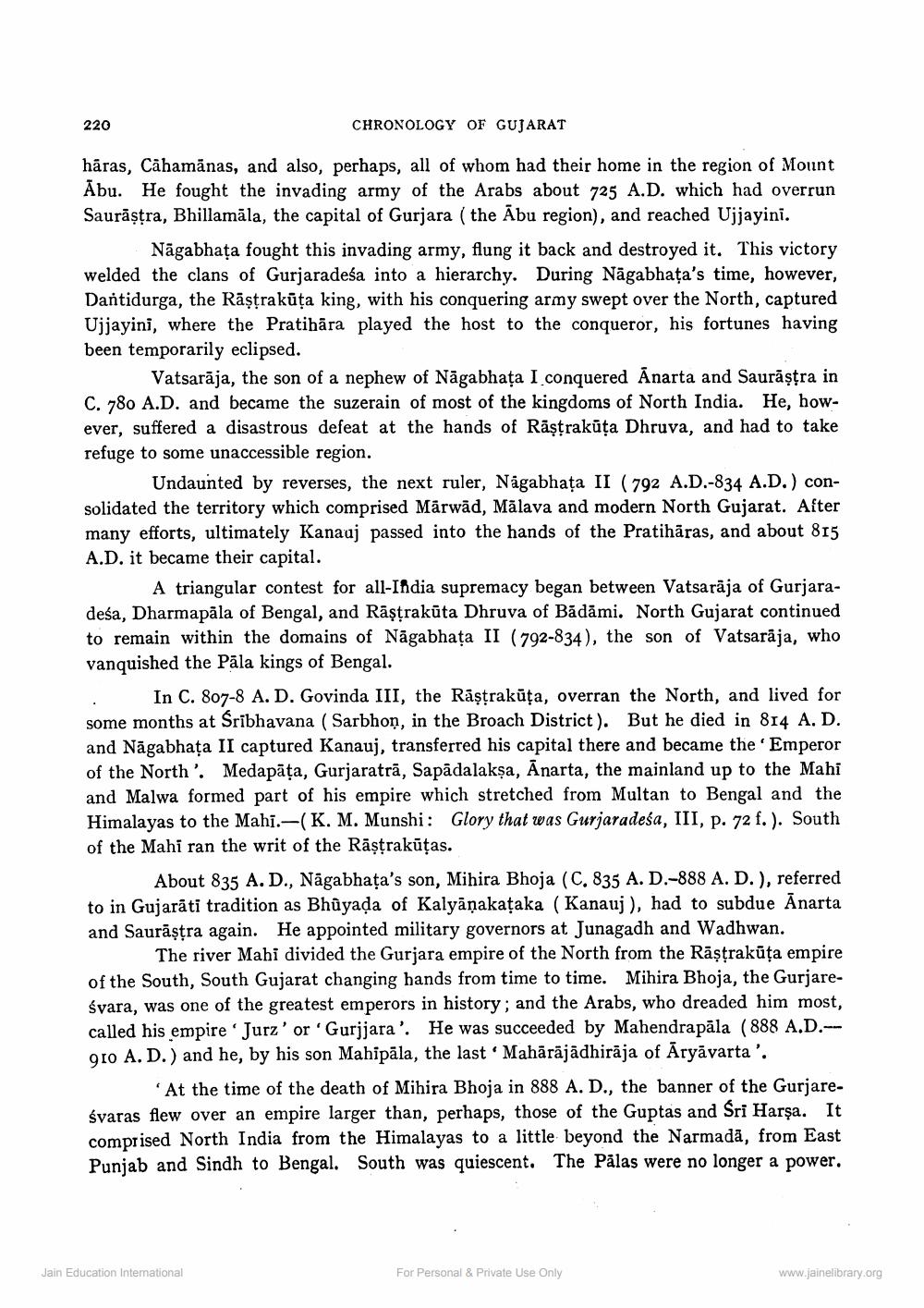________________
220
CHRONOLOGY OF GUJARAT
hāras, Cahamānas, and also, perhaps, all of whom had their home in the region of Mount Ābu. He fought the invading army of the Arabs about 725 A.D. which had overrun Saurāșțra, Bhillamāla, the capital of Gurjara ( the Abu region), and reached Ujjayini.
Nāgabhața fought this invading army, flung it back and destroyed it. This victory welded the clans of Gurjaradeśa into a hierarchy. During Nāgabhata's time, however, Dantidurga, the Rāştrakūta king, with his conquering army swept over the North, captured Ujjayini, where the Pratihāra played the host to the conqueror, his fortunes having been temporarily eclipsed.
Vatsarāja, the son of a nephew of Nāgabhața I conquered Anarta and Saurāştra in C. 780 A.D. and became the suzerain of most of the kingdoms of North India. He, however, suffered a disastrous defeat at the hands of Rāştrakūta Dhruva, and had to take refuge to some unaccessible region.
Undaunted by reverses, the next ruler, Nagabhața II (792 A.D.-834 A.D.) consolidated the territory which comprised Mārwad, Mālava and modern North Gujarat. After many efforts, ultimately Kanaaj passed into the hands of the Pratihāras, and about 815 A.D. it became their capital.
A triangular contest for all-India supremacy began between Vatsarāja of Gurjaradeśa, Dharmapāla of Bengal, and Rāştrakūta Dhruva of Bădāmi. North Gujarat continued to remain within the domains of Nāgabhata II (792-834), the son of Vatsarāja, who vanquished the Pāla kings of Bengal.
In C. 807-8 A. D. Govinda III, the Rāştrakūta, overran the North, and lived for some months at Sribhavana (Sarbhon, in the Broach District). But he died in 814 A. D. and Nāgabhasa II captured Kanauj, transferred his capital there and became the 'Emperor of the North'. Medapāța, Gurjaratrā, Sapädalakṣa, Ānarta, the mainland up to the Mahi and Malwa formed part of his empire which stretched from Multan to Bengal and the Himalayas to the Mahi.-(K. M. Munshi: Glory that was Gurjaradeśa, III, p. 72 f.). South of the Mahi ran the writ of the Rāştrakūtas.
About 835 A. D., Nāgabhata's son, Mihira Bhoja (C. 835 A. D.-888 A.D.), referred to in Gujarati tradition as Bhùyada of Kalyāņakațaka ( Kanauj), had to subdue Anarta and Saurāșțra again. He appointed military governors at Junagadh and Wadhwan.
The river Mahi divided the Gurjara empire of the North from the Rāştrakūta empire of the South, South Gujarat changing hands from time to time. Mihira Bhoja, the Gurjareśvara, was one of the greatest emperors in history; and the Arabs, who dreaded him most, called his empire Jurz' or 'Gurjjara'. He was succeeded by Mahendra pāla (888 A.D.-- 910 A. D.) and he, by his son Mahipāla, the last Mahāräjādhirāja of Āryävarta'.
At the time of the death of Mihira Bhoja in 888 A. D., the banner of the Gurjareśvaras flew over an empire larger than, perhaps, those of the Guptas and Sri Harsa. It comprised North India from the Himalayas to a little beyond the Narmadā, from East Punjab and Sindh to Bengal, South was quiescent. The Palas were no longer a power.
Jain Education Interational
For Personal & Private Use Only
www.jainelibrary.org




